
|
| Spring 1998
| Vol. VII, No. 1
|
In This Issue:
|
Hardwood Staking: One Way to Protect and Improve Streams
A recently planted willow stake
just beginning to sprout.
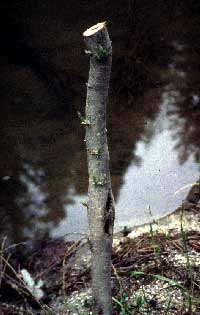
|
Healthy riparian areas around rivers and creeks in Trinity County have lush, dense vegetation that typically consists of cottonwood and alder trees, willows, and wildflowers like tiger lilies and Solomon’s seal. Such healthy riparian areas are important for many reasons, foremost for protecting streambanks from erosion. Riparian areas also provide habitat for anadromous fish, such as steelhead and Chinook salmon, by shading the water, which helps keep water temperatures cool for young fish during the summer months. Organic debris from streamside vegetation that falls into the creeks, such as logs and large branches, creates protected habitat for both juvenile and adult fish. Riparian vegetation is also important for providing habitat and forage for numerous wildlife species.
Activities such as land clearing and unmanaged cattle grazing can degrade riparian areas so that little or no vegetation is left to protect streambanks. There are many ways landowners can improve riparian areas on their properties, including hardwood staking. Hardwood staking is a simple and inexpensive means of increasing vegetation along bare or sparse areas along your creek.
The technique is simple. Stakes are cut from willow or cottonwood branches when the plants are dormant, usually from late November to early March (after the leaves fall in autumn and before the buds open in spring). The stakes are usually 1 to 4 inches in diameter and 3 to 5 feet in length. You will want to choose branches that are at least one-year old but avoid very old wood and suckers (thin branches that sprout from fallen branches or exposed roots).
A typical streambank erosion problem
that can be helped by planting new
riparian vegetation.
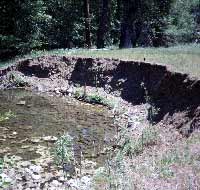
|
After a straight branch is cut, the limbs are removed and the cut end is sealed with a 50/50 mixture of white latex paint and water, which reduces desiccation (drying out) of the stake. Soak either the bottom half or the entire stake in water for at least 24 hours but no more than 7 days just before planting. After soaking, install the stakes with the growth buds up (the white tip can be cut off prior to planting). Stakes should be installed at stream edges so that the below-ground portion of the stake will be in contact with moist soil even during the summer months. If there is an eroding bank you wish to stabilize with vegetation, then plant stakes at the base of the slope.
Stake holes can be dug with either a shovel or auger, and for larger projects, a backhoe can be used to dig a trench for multiple plantings. Willow stakes should be planted 1 to 3 feet apart and cottonwood stakes 3 to 5 feet apart. After planting, it is important to pack the soil around the stake to remove any air pockets. Stakes will begin sprouting in the spring, with willows forming large shrubs within one to five years (cottonwoods will take longer to establish).
A crew member readies a willow
wattle for planting riparian vegetation.
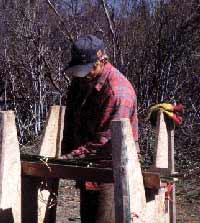
|
Another technique for establishing riparian vegetation which requires a little more labor but tends to be more successful is the installation of willow wattles. Willow wattles are constructed of very thin new-growth branches bound together and buried in a trench along the margins of a creek. The length of the wattles varies from 3 to 6 feet, depending on accessibility of the site and size of the area treated. For ease of assembly, the cuttings can be assembled in specially built troughs designed to hold several cuttings in place while the bundles are tied at the ends (see photo, left).
When installing the bundles, a trench about 4 to 6 inches deep is dug with a trenching shovel. Trenches may be dug either parallel or perpendicular to the stream, depending on the site. Bundles are placed in the troughs with the ends of each bundle sticking out of the trough. The rest of the wattle is then covered with soil and packed down. The hardwood stakes discussed above can be installed alongside the wattles to hold them in place. The buried section of each wattle will sprout roots and the exposed ends will leaf out quickly to form shrubby growth. If stakes are used, these will sprout as well.
For more information on hardwood staking or maintaining streambanks, please contact the Trinity County RCD office for a free brochure entitled, "Riparian Care Guide."
Return to This Issue's index.
|
|
Watershed Analysis Team Completes Draft
A draft of the East Fork/Smoky Creek Watershed
Analysis (WA) has been completed and has been
delivered to the US Forest Service for review by the
Hayfork District Ranger. The WA--a study of ecosystem
elements and functions that focuses on discovering
potential management actions such as restoration,
monitoring, fire protection, and timber harvest
opportunities--is a detailed analysis of the watersheds that
includes descriptions of past and current conditions,
key issues and questions that concern the watersheds,
and recommendations for management activities. This
particular WA was unusual in that it teamed up diverse
agencies and individuals and sought to study characteristics
of two, adjacent, watersheds, rather than the usual
study area of one watershed. The WA took longer to
prepare than previously anticipated, partly because of the
quantity of available information that had to be synthesized
and partly because it did encompass a larger area
than is usual with a WA.
Team members are satisfied, however, that they have
accurately characterized the watersheds and presented
suitable recommendations based on their research. The
WA also includes over 32 detailed maps of the area;
extensive tables of information including threatened,
endangered, and sensitive plant and animal species;
timber stand information; and fire histories of the watersheds.
Copies of the WA will become available from the Hayfork
Ranger District once the District Ranger has completed
a review of the draft.
Return to This Issue's index. |
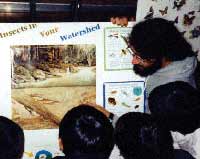
AmeriCorps Hosts Bug Fair at Hoopa Elementary
Samala Maloney, AmeriCorps community coordinator for Hoopa Valley, hosted an “Insect Fair” at Hoopa Elementary on January 22. AmeriCorps members from all over Trinity County organized, designed, and ran the event, which took place in the school Gym and lasted all day. Members manned various stations and taught children about the life cycles, anatomy, and behavior of bugs. The gym was divided into two sections, one each for primary- and intermediate-grade kids. In the primary section, kids were treated to a butterfly display (with over 100 specimens exhibited), explained by Greg DiBenedetto; a spider web game, hosted by Vicky Guarracino and Joe Bentley, wherein kids had to crawl through a rope net without touching the rope (spiders are alerted that prey is caught in their webs when they feel movement); a story telling station, where John Garrett told Native American stories that explain how various insects acquired their characteristic
features (“Why Mosquitoes Buzz in Your Ears,” for example); and two puppet shows put on by Charlotte Mann and Heather Finger that explained the life cycle of butterflies as well as what spiders will and will not eat.
In the Intermediate section, Julie Fleener and Tina Roczey, hosted a free bug feed, where kids had a chance to sample the cuisine of Aboriginal Australians: meal worms, sautéed in garlic butter (many kids were actually bold enough to eat these squirmy critters); Kane Zink hosted a live bug display, with huge monsters such as the Indonesian Hissing Cockroach, a cute 5-inch-long creature which Kane would let you hold and pet; AmeriCorps regional coordinator Shannon Murray and John Jarvis manned a create-your-own-bug station that allowed kids to fashion insects such as they had observed in previous stations from various art materials; and lastly, Karen LaMoncha (the AmeriCorps resident entomologist) presented another butterfly and bug display of hundreds of insects that the older kids could view and read about. AmeriCorps member Patrick Lowney photographed the event.
The children really enjoyed themselves as they learned about the differences between various classes of bugs, what kind of habitat favored by each, and, most important, which bugs eat which. Return to This Issue's index.
Recent Projects
Planting Dominates Season's Work
Erosion control and equipment work slow down considerably once the fall rains begin. Fall and early winter work by the RCD is generally limited to planting, as road drainage and other related work becomes unfeasible (and inaccessible) once the ground becomes saturated from rain- and snowfall. Planting can continue, however, until the ground freezes or snow makes work sites inaccessible.
Fall Planting
The revegetation program had a productive fall planting season, with a total of 56,000 seedlings planted. Areas planted included the Grass Valley Creek watershed, Indian Creek, and riparian areas in Hayfork. The four-week planting season began on December 1st and continued through December 29th. Planting was discontinued when the ground became too frozen to work in and lands became inaccessible due to snow.
In Grass Valley Creek 51,000 conifers, shrubs and grass seedlings were planted, including the following species: ponderosa pine, deerbrush, Lemmon’s ceanothus, blue wildrye, and squirreltail.
In Indian Creek, a total of 3,000 tree, shrub, and grass plugs were planted in two days. Due to the unpredictable nature of the stream flow through the project area, only selected upper terraces (five sites) were planted to ensure that plants would not be washed away during the winter. Ponderosa pine, Lemmon’s ceanothus, and blue wildrye were planted on the terraces, with deerbush planted on the steep banks that border the area.
In the Hayfork Valley, a total of 2,000 seedlings (mostly ponderosa pine) were planted along Barker, Salt, and Tule Creeks for riparian improvement. Nearly 1,500 seedlings were planted along Tule Creek on the L & M Ranch, behind the cattle-exclusion fence constructed by the RCD this past summer. Ponderosa pine was also planted on the Kenerson property along Salt Creek in the vicinity of the stream stabilization work that was completed there. The remaining seedlings were planted along Barker Creek on seven properties where landowners were interested in improving the vegetation along their reach of the creek.
Monitoring
The 1997 monitoring report for the revegetation program has been completed. Christina will present this report to the Board of Directors at the February 18 Board meeting and explain the major findings that were found through this year’s monitoring efforts.
For monitoring this fall, nine sample sites were selected to monitor seedling survivability. This included shrub and grass plug monitoring, which consisted of flagging 50 seedlings of each species on monitor sites for future identification (a subsample of 350 shrubs and 150 grasses were flagged).
South Fork Projects
Winter snows have shut down all reconnaissance work for RCD and NRCS engineering field staff for the winter. They will be compiling data collected this past fall and putting plans together. Approximately 1,200 feet of cattle-exclusion fencing was installed on Carr Creek by the end of November. On January 7 the RCD crew finished installing approximately 9,000 feet of cattle-exclusion fencing, including three crossings, on a Ranch located on Big Creek.
Return to This Issue's index.
Non-Timber Forest Products Guide Published
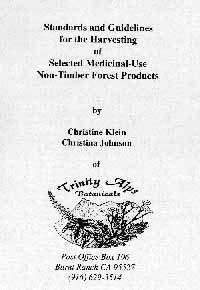 Christine Klein and Christina Johnson of Trinity Alps Botanicals have recently published Standards and Guidelines for Harvesting of Selected Medicinal-Use Non-Timber Forest Products. Trinity Alps Botanicals is a non-profit agricultural cooperative in Northern California that produces and markets “quality sustainably wildcrafted and organically grown medicinal herbs.” In addition, they have been dedicated, since 1991, to “providing income opportunities for local forest-dependent communities.” Christine Klein and Christina Johnson of Trinity Alps Botanicals have recently published Standards and Guidelines for Harvesting of Selected Medicinal-Use Non-Timber Forest Products. Trinity Alps Botanicals is a non-profit agricultural cooperative in Northern California that produces and markets “quality sustainably wildcrafted and organically grown medicinal herbs.” In addition, they have been dedicated, since 1991, to “providing income opportunities for local forest-dependent communities.”
Interest in harvesting Non-Timber Forest Products (NTFP’s) has increased in recent years, as opportunities to harvest commercial wood products have dwindled. NTFP’s include many different, potentially salable, products including wild mushrooms, medicinal plants, and other commodities. Since the cooperative is dedicated to producing and disseminating information about medicinal herbs, the authors have chosen to highlight these NTFP’s specifically in their publication.
The purpose of the pamphlet, which includes numerous color reproductions of the herbs to aid in identifying them, is “to help ensure that the wildcrafting and harvest of medicinal herbs are of the highest possible quality, while protecting the plants, their habitats and all other living things. The focus is on harvesting naturalized weedy species with low cultural and ecological sensitivity for medicinal uses.”
Although the pamphlet presents specific information on a number of plants--such as Mullein, St. John’s Wort, and Yarrow--and is well written and designed, the authors state that it is meant to be revised to include other plants and information as these become available. Therefore, the pamphlet is loose-leaf bound to allow for additions as these become available. The pamphlet, which costs $20.00 (the relatively high cost is due to the expense for color reproduction), is available through the Trinity County RCD (contact Scott Brennan-Smith) or from Trinity Alps Botanicals @ 629-3514.
Return to This Issue's index.
Employee Feature
Cynthia Tarwater: Making it Happen
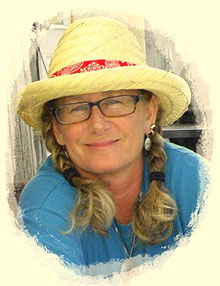 Cynthia Tarwater, Project Implementation Coordinator for the RCD, has been with the District since the spring of 1993. Cynthia assesses and prioritizes road drainage improvement projects on both private and public lands in the county. Roads with poor drainage can deliver large amounts of sediment to streams and rivers in the Trinity River basin, harming anadromous fish habitat and other ecosystem functions. Road drainage improvement projects include installing or upgrading culverts, installing rolling dips, and redesigning roads to facilitate less concentrated runoff. Initially, Cynthia’s work focused on lands around Grass Valley Creek, a major sediment source to the mainstem Trinity River, but her work has now expanded to
encompass other areas of the Trinity River system, most recently the Upper South Fork Trinity River. Cynthia Tarwater, Project Implementation Coordinator for the RCD, has been with the District since the spring of 1993. Cynthia assesses and prioritizes road drainage improvement projects on both private and public lands in the county. Roads with poor drainage can deliver large amounts of sediment to streams and rivers in the Trinity River basin, harming anadromous fish habitat and other ecosystem functions. Road drainage improvement projects include installing or upgrading culverts, installing rolling dips, and redesigning roads to facilitate less concentrated runoff. Initially, Cynthia’s work focused on lands around Grass Valley Creek, a major sediment source to the mainstem Trinity River, but her work has now expanded to
encompass other areas of the Trinity River system, most recently the Upper South Fork Trinity River.
Originally from Florida, Cynthia relocated to San Diego in 1985 and began community college there. After three years in San Diego, and wanting to attend a smaller university, she transferred to Humboldt State University and completed a Bachelor of Arts Degree in Geography in 1991, while living in Blue Lake. After completing her degree she worked for the US Forest Service in Willow Creek until starting at the RCD in 1993.
“What I like most about my position is to see a project through to the finish: planning, design, and implementation. I also can’t knock the fact that I spend a great deal of time outdoors in remote Trinity County locations and have found very nice people, with loads of local history and stories.” Cynthia has especially enjoyed working with all the local equipment operators, and she gives special recognition to Rich Roberts, engineer with the Natural Resources Conservation Service with whom she works closely, for designing the projects she implements. She is also very appreciative of the RCD crew members who assist her with “making it happen in the field.”
Cynthia has decided to make Trinity County her home. In 1995 she purchased property in Big Bar and now resides here full time. Cynthia maintains close ties with her family, taking annual trips to Florida to visit. In her spare time she enjoys backpacking, investigating local history, gardening, craftwork, visiting the coast, and “just hanging at the river.”
Return to This Issue's index.
Board of Supervisors to Appoint New RCD Board Member
Recently, the RCD Board of Directors advertised an opening on the board for a new board member in the Trinity Journal. The RCD received four responses from interested landowners in the county. After meeting with the prospective candidates, the board selected two local landowners, Joel Hedberg and Mike Rourke , whom they would recommend to the Trinity County Board Of Supervisors to be considered for the position. The Board of Supervisors appoints RCD Board members.
Board members are appointed to set policy for governing issues.
The current vacancy is the result of the resignation of former Board Member Ken Jones. A five member board is considered the minimum for an RCD board.
At the January 21st RCD Board meeting, the board voted to determine who would be Chair and Vice Chair of the board for 1998.Greg Lowden was elected to serve as Chair, and Rose Owens chosen to serve as Vice-Chair of the board of Directors. Congratulations to both of you!
Return to This Issue's index.
Return to the Trinity County RCD Home Page
|








 Christine Klein and Christina Johnson of Trinity Alps Botanicals have recently published Standards and Guidelines for Harvesting of Selected Medicinal-Use Non-Timber Forest Products. Trinity Alps Botanicals is a non-profit agricultural cooperative in Northern California that produces and markets “quality sustainably wildcrafted and organically grown medicinal herbs.” In addition, they have been dedicated, since 1991, to “providing income opportunities for local forest-dependent communities.”
Christine Klein and Christina Johnson of Trinity Alps Botanicals have recently published Standards and Guidelines for Harvesting of Selected Medicinal-Use Non-Timber Forest Products. Trinity Alps Botanicals is a non-profit agricultural cooperative in Northern California that produces and markets “quality sustainably wildcrafted and organically grown medicinal herbs.” In addition, they have been dedicated, since 1991, to “providing income opportunities for local forest-dependent communities.”
 Cynthia Tarwater, Project Implementation Coordinator for the RCD, has been with the District since the spring of 1993. Cynthia assesses and prioritizes road drainage improvement projects on both private and public lands in the county. Roads with poor drainage can deliver large amounts of sediment to streams and rivers in the Trinity River basin, harming anadromous fish habitat and other ecosystem functions. Road drainage improvement projects include installing or upgrading culverts, installing rolling dips, and redesigning roads to facilitate less concentrated runoff. Initially, Cynthia’s work focused on lands around
Cynthia Tarwater, Project Implementation Coordinator for the RCD, has been with the District since the spring of 1993. Cynthia assesses and prioritizes road drainage improvement projects on both private and public lands in the county. Roads with poor drainage can deliver large amounts of sediment to streams and rivers in the Trinity River basin, harming anadromous fish habitat and other ecosystem functions. Road drainage improvement projects include installing or upgrading culverts, installing rolling dips, and redesigning roads to facilitate less concentrated runoff. Initially, Cynthia’s work focused on lands around